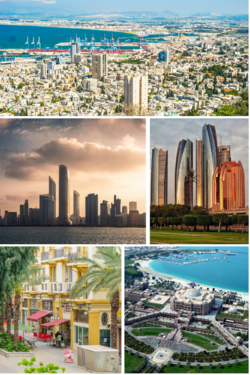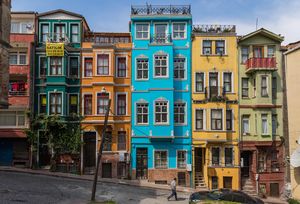Afąván
Afąván
. Afąván . | |
|---|---|
Metropolis | |
 Clockwise from top: Aerial view of the Afąváni Marina, Skyline of the city center at dawn, View of the Avir Skyscrapers from Erdema Park, Elivara Coastal Boulevard, the Hagvidašeir Palace | |
| Etymology: City on the White Beach | |
| Nickname(s): City of Beaches and Seafood | |
| Country | Lenezan |
| Region | Coastal |
| Government | |
| • Mayor | Caru Šarumašeir |
| Area | |
| • Metro | 1,092 km2 (422 sq mi) |
| Population (2018) | |
| • Metropolis | 3,266,680 |
| • Density | 2,991/km2 (7,750/sq mi) |
| Demonym(s) | Afąvánite, Afąvánese |
| Time zone | Sahar Coordinated Time (SCT+2) |
Afąván(Siyan: [ɐfɐ̃va:n]), is the capital city of the Hasafą province. With a recorded population of 3,266,680 in 2021, it is the most populous city in Lenezan and the X most populous city in Vaniua. The city is the anchor of the Golden Coast, an urban agglomeration of 13,129,843 people (as of 2021) situated on the Lenezi coast, while the Greater Afąván Area proper had a 2021 population of 5,436,701. Afąván is an regional center of STEM, business, fashion, arts, sports, and culture, and is recognized as one of the most multicultural and cosmopolitan cities in Vaniua. It's also the center of the Segeriseta film industry, which is most popular amongst Vaniuan countries.
As of 2019, Afąván twinned with the Koman city of Samadar via a recently developed government-led program that allows for academic, and economic collaboration between both cities, including the establishment of FDI incentives.
Etymology
History
Prehistory of Afąván
Ahiri Rule
Qasamist Rule
Lenefámi Rule
Middle Ages and the Béšerasi
The 18th and 19th Centuries
Post-2nd Lenezi Civil War
21st Century
Geography
Climate
Cityscape
Architecture
Landmarks
Other Iconic Sights
Culture
Economy
Government
Demographics
International relations
- Pages with non-numeric formatnum arguments
- Articles with short description
- Pages using infobox settlement with possible demonym list
- Pages using infobox settlement with unknown parameters
- Pages using infobox settlement with no map
- Pages using infobox settlement with no coordinates
- Settlements
- Lenezi settlements

